
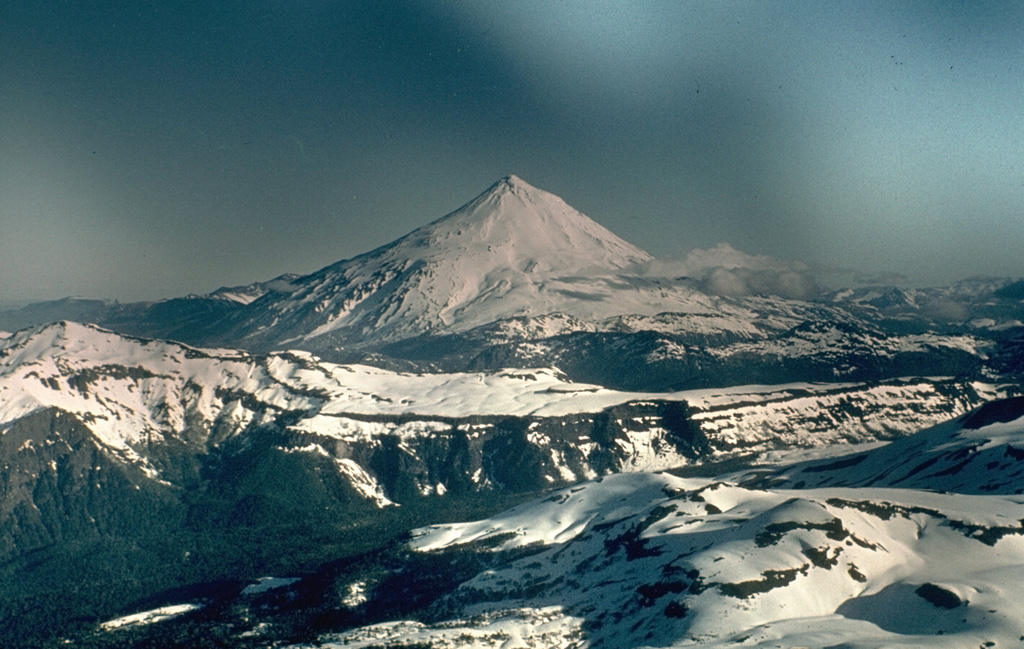
Servicio Nacional de Geología and Minería (SERNAGEOMIN) Observatorio Volcanológico de Los Andes del Sur (OVDAS) reported that beginning at 1524 on 15 February a seismic swarm at Lanin, consisting of 59 volcanic-tectonic, long-period, and spasmodic tremor events, lasted for 45 minutes. The largest volcano-tectonic event was a M 1.8. The Alert Level was raised to Yellow (second highest level on a four-color scale); ONEMI declared an Alert Level Yellow (the middle level on a three-color scale) for the community of Curarrehue (32 km N).
Sources: Servicio Nacional de Geología y Minería (SERNAGEOMIN), Oficina Nacional de Emergencia-Ministerio del Interior (ONEMI)
2017: February
Servicio Nacional de Geología and Minería (SERNAGEOMIN) Observatorio Volcanológico de Los Andes del Sur (OVDAS) reported that beginning at 1524 on 15 February a seismic swarm at Lanin, consisting of 59 volcanic-tectonic, long-period, and spasmodic tremor events, lasted for 45 minutes. The largest volcano-tectonic event was a M 1.8. The Alert Level was raised to Yellow (second highest level on a four-color scale); ONEMI declared an Alert Level Yellow (the middle level on a three-color scale) for the community of Curarrehue (32 km N).
Sources: Servicio Nacional de Geología y Minería (SERNAGEOMIN); Oficina Nacional de Emergencia-Ministerio del Interior (ONEMI)
The Global Volcanism Program has no Bulletin Reports available for Lanín.
|
|
||||||||||||||||||||||||||||
There is data available for 8 confirmed eruptive periods.
0560 ± 150 years Confirmed Eruption (Explosive / Effusive)
| Episode 1 | Eruption (Explosive / Effusive) | |||||||||||||||||||
|---|---|---|---|---|---|---|---|---|---|---|---|---|---|---|---|---|---|---|---|
| 0560 ± 150 years - Unknown | Evidence from Isotopic: 14C (calibrated) | ||||||||||||||||||
|
List of 2 Events for Episode 1
|
|||||||||||||||||||
0400 ± 150 years Confirmed Eruption (Explosive / Effusive)
| Episode 1 | Eruption (Explosive / Effusive) | |||||||||||||||||||
|---|---|---|---|---|---|---|---|---|---|---|---|---|---|---|---|---|---|---|---|
| 0400 ± 150 years - Unknown | Evidence from Isotopic: 14C (calibrated) | ||||||||||||||||||
|
List of 2 Events for Episode 1
|
|||||||||||||||||||
0090 ± 300 years Confirmed Eruption (Explosive / Effusive) VEI: 0
| Episode 1 | Eruption (Explosive / Effusive) | Quillelhue Basalts | ||||||||||||||||||
|---|---|---|---|---|---|---|---|---|---|---|---|---|---|---|---|---|---|---|---|
| 0090 ± 300 years - Unknown | Evidence from Correlation: Tephrochronology | ||||||||||||||||||
|
List of 2 Events for Episode 1 at Quillelhue Basalts
|
|||||||||||||||||||
0080 BCE ± 200 years Confirmed Eruption (Explosive / Effusive)
| Episode 1 | Eruption (Explosive / Effusive) | |||||||||||||||||||
|---|---|---|---|---|---|---|---|---|---|---|---|---|---|---|---|---|---|---|---|
| 0080 BCE ± 200 years - Unknown | Evidence from Isotopic: 14C (calibrated) | ||||||||||||||||||
|
List of 2 Events for Episode 1
|
|||||||||||||||||||
0220 BCE ± 200 years Confirmed Eruption (Explosive / Effusive)
| Episode 1 | Eruption (Explosive / Effusive) | Mamuil Malal dome | ||||||||||||||||||||||||||||||||||||||
|---|---|---|---|---|---|---|---|---|---|---|---|---|---|---|---|---|---|---|---|---|---|---|---|---|---|---|---|---|---|---|---|---|---|---|---|---|---|---|---|
| 0220 BCE ± 200 years - Unknown | Evidence from Isotopic: 14C (calibrated) | ||||||||||||||||||||||||||||||||||||||
|
List of 6 Events for Episode 1 at Mamuil Malal dome
|
|||||||||||||||||||||||||||||||||||||||
0590 BCE ± 200 years Confirmed Eruption (Explosive / Effusive)
| Episode 1 | Eruption (Explosive / Effusive) | |||||||||||||||||||
|---|---|---|---|---|---|---|---|---|---|---|---|---|---|---|---|---|---|---|---|
| 0590 BCE ± 200 years - Unknown | Evidence from Isotopic: 14C (calibrated) | ||||||||||||||||||
|
List of 2 Events for Episode 1
|
|||||||||||||||||||
6340 BCE ± 200 years Confirmed Eruption (Explosive / Effusive)
| Episode 1 | Eruption (Explosive / Effusive) | |||||||||||||||||||
|---|---|---|---|---|---|---|---|---|---|---|---|---|---|---|---|---|---|---|---|
| 6340 BCE ± 200 years - Unknown | Evidence from Isotopic: 14C (calibrated) | ||||||||||||||||||
|
List of 2 Events for Episode 1
|
|||||||||||||||||||
9240 BCE ± 500 years Confirmed Eruption (Explosive / Effusive)
| Episode 1 | Eruption (Explosive / Effusive) | |||||||||||||||||||
|---|---|---|---|---|---|---|---|---|---|---|---|---|---|---|---|---|---|---|---|
| 9240 BCE ± 500 years - Unknown | Evidence from Isotopic: 14C (calibrated) | ||||||||||||||||||
|
List of 2 Events for Episode 1
|
|||||||||||||||||||
This compilation of synonyms and subsidiary features may not be comprehensive. Features are organized into four major categories: Cones, Craters, Domes, and Thermal Features. Synonyms of features appear indented below the primary name. In some cases additional feature type, elevation, or location details are provided.
Cones |
||||
| Feature Name | Feature Type | Elevation | Latitude | Longitude |
| Arenal, Volcán | Tuff ring | 1560 m | 39° 40' 0.00" S | 71° 35' 17.00" W |
| Paimún Cones | Pyroclastic cone | |||
Craters |
||||
| Feature Name | Feature Type | Elevation | Latitude | Longitude |
| Huinfiuca | Fissure vent | |||
Domes |
||||
| Feature Name | Feature Type | Elevation | Latitude | Longitude |
| Mamuil Malal | Dome | |||
 Volcán Lanín is a large conical late-Pleistocene to Holocene stratovolcano along the Chile-Argentina border. The beautifully symmetrical, 3737-m-high Lanín, seen here from the Chilean side, rises 2500 m above its base. A small lava dome at the summit fed blocky lava flows to the north. A postglacial tuff ring (Volcán Arenal) is located below the SW flank of Lanín in Argentina. A younger lava flow from Lanín covers deposits of Volcán Arenal and extends south into Lago Paimún. No reliable reports of historical eruptions from Lanín are known.
Volcán Lanín is a large conical late-Pleistocene to Holocene stratovolcano along the Chile-Argentina border. The beautifully symmetrical, 3737-m-high Lanín, seen here from the Chilean side, rises 2500 m above its base. A small lava dome at the summit fed blocky lava flows to the north. A postglacial tuff ring (Volcán Arenal) is located below the SW flank of Lanín in Argentina. A younger lava flow from Lanín covers deposits of Volcán Arenal and extends south into Lago Paimún. No reliable reports of historical eruptions from Lanín are known.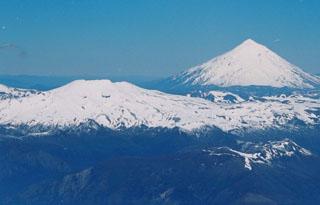 Quetrupillan stratovolcano (left) lies at the center of a group of three volcanoes trending transverse to the Andean chain. It is seen here from the summit of Villarrica volcano (at the western end of the chain), with conical Lanín volcano at the eastern end in the background. The 2360-m-high Quetrupillan volcano was constructed within a large 7 x 10 km wide caldera; a smaller caldera truncates the summit. Some of the most recent activity produced pyroclastic cones along the right-hand flank, near the SW margin of the older caldera.
Quetrupillan stratovolcano (left) lies at the center of a group of three volcanoes trending transverse to the Andean chain. It is seen here from the summit of Villarrica volcano (at the western end of the chain), with conical Lanín volcano at the eastern end in the background. The 2360-m-high Quetrupillan volcano was constructed within a large 7 x 10 km wide caldera; a smaller caldera truncates the summit. Some of the most recent activity produced pyroclastic cones along the right-hand flank, near the SW margin of the older caldera. 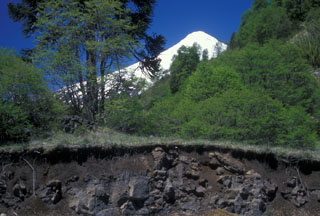 The lava flow in the foreground roadcut is part of the Quillelhue Basalts, which were erupted from an area at about 2600 m altitude on the NNW flank of Lanín, the snow-capped volcano in the background. The lavas form a basaltic field that reaches as far as Quillelhue Lake, more than 5 km from their source. The flows are bracketed by 2170 BP date for the Mamuil Malal dacitic block-and-ash flow and a 1650 BP date for an overlying pyroclastic-flow deposit.
The lava flow in the foreground roadcut is part of the Quillelhue Basalts, which were erupted from an area at about 2600 m altitude on the NNW flank of Lanín, the snow-capped volcano in the background. The lavas form a basaltic field that reaches as far as Quillelhue Lake, more than 5 km from their source. The flows are bracketed by 2170 BP date for the Mamuil Malal dacitic block-and-ash flow and a 1650 BP date for an overlying pyroclastic-flow deposit. 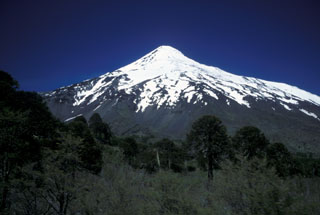 Snow-capped Lanín volcano rises to the SSW above the Chile/Argentina border. A grove of distinctive Araucaria trees ("monkey puzzle trees") occupy the foreground. These distinctive trees are one of Chile's most renowned conifers and are confined to restricted areas in the Andes. Fossils reveal that this genus was once extremely widespread, leaving behind petrified woods in Arizona and amber deposits around the globe. The Auracaria occurs today only in Chile, one small region in Brazil, a few places in Australia, and New Caledonia.
Snow-capped Lanín volcano rises to the SSW above the Chile/Argentina border. A grove of distinctive Araucaria trees ("monkey puzzle trees") occupy the foreground. These distinctive trees are one of Chile's most renowned conifers and are confined to restricted areas in the Andes. Fossils reveal that this genus was once extremely widespread, leaving behind petrified woods in Arizona and amber deposits around the globe. The Auracaria occurs today only in Chile, one small region in Brazil, a few places in Australia, and New Caledonia.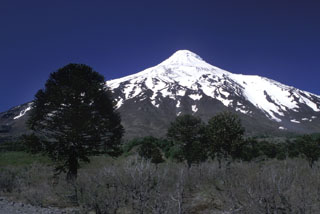 Lanín volcano rises to the south above a grove of distinctive Araucaria trees near the Chile/Argentina border. The beautifully symmetrical, 3737-m-high Lanín towers 2500 m above its base. The prominent shoulder area on the upper western (right horizon) and northern flanks hint at a buried caldera. The volcano was formed by dominantly effusive basaltic-to-trachydacitic eruptions at the eastern end of a NW-SE-trending volcanic group beginning with Villarrica on the west that is transverse to the Andean chain.
Lanín volcano rises to the south above a grove of distinctive Araucaria trees near the Chile/Argentina border. The beautifully symmetrical, 3737-m-high Lanín towers 2500 m above its base. The prominent shoulder area on the upper western (right horizon) and northern flanks hint at a buried caldera. The volcano was formed by dominantly effusive basaltic-to-trachydacitic eruptions at the eastern end of a NW-SE-trending volcanic group beginning with Villarrica on the west that is transverse to the Andean chain. There are no samples for Lanín in the Smithsonian's NMNH Department of Mineral Sciences Rock and Ore collection.
| Copernicus Browser | The Copernicus Browser replaced the Sentinel Hub Playground browser in 2023, to provide access to Earth observation archives from the Copernicus Data Space Ecosystem, the main distribution platform for data from the EU Copernicus missions. |
| MIROVA | Middle InfraRed Observation of Volcanic Activity (MIROVA) is a near real time volcanic hot-spot detection system based on the analysis of MODIS (Moderate Resolution Imaging Spectroradiometer) data. In particular, MIROVA uses the Middle InfraRed Radiation (MIR), measured over target volcanoes, in order to detect, locate and measure the heat radiation sourced from volcanic activity. |
| MODVOLC Thermal Alerts | Using infrared satellite Moderate Resolution Imaging Spectroradiometer (MODIS) data, scientists at the Hawai'i Institute of Geophysics and Planetology, University of Hawai'i, developed an automated system called MODVOLC to map thermal hot-spots in near real time. For each MODIS image, the algorithm automatically scans each 1 km pixel within it to check for high-temperature hot-spots. When one is found the date, time, location, and intensity are recorded. MODIS looks at every square km of the Earth every 48 hours, once during the day and once during the night, and the presence of two MODIS sensors in space allows at least four hot-spot observations every two days. Each day updated global maps are compiled to display the locations of all hot spots detected in the previous 24 hours. There is a drop-down list with volcano names which allow users to 'zoom-in' and examine the distribution of hot-spots at a variety of spatial scales. |
|
WOVOdat
Single Volcano View Temporal Evolution of Unrest Side by Side Volcanoes |
WOVOdat is a database of volcanic unrest; instrumentally and visually recorded changes in seismicity, ground deformation, gas emission, and other parameters from their normal baselines. It is sponsored by the World Organization of Volcano Observatories (WOVO) and presently hosted at the Earth Observatory of Singapore.
GVMID Data on Volcano Monitoring Infrastructure The Global Volcano Monitoring Infrastructure Database GVMID, is aimed at documenting and improving capabilities of volcano monitoring from the ground and space. GVMID should provide a snapshot and baseline view of the techniques and instrumentation that are in place at various volcanoes, which can be use by volcano observatories as reference to setup new monitoring system or improving networks at a specific volcano. These data will allow identification of what monitoring gaps exist, which can be then targeted by remote sensing infrastructure and future instrument deployments. |
| Volcanic Hazard Maps | The IAVCEI Commission on Volcanic Hazards and Risk has a Volcanic Hazard Maps database designed to serve as a resource for hazard mappers (or other interested parties) to explore how common issues in hazard map development have been addressed at different volcanoes, in different countries, for different hazards, and for different intended audiences. In addition to the comprehensive, searchable Volcanic Hazard Maps Database, this website contains information about diversity of volcanic hazard maps, illustrated using examples from the database. This site is for educational purposes related to volcanic hazard maps. Hazard maps found on this website should not be used for emergency purposes. For the most recent, official hazard map for a particular volcano, please seek out the proper institutional authorities on the matter. |
| IRIS seismic stations/networks | Incorporated Research Institutions for Seismology (IRIS) Data Services map showing the location of seismic stations from all available networks (permanent or temporary) within a radius of 0.18° (about 20 km at mid-latitudes) from the given location of Lanín. Users can customize a variety of filters and options in the left panel. Note that if there are no stations are known the map will default to show the entire world with a "No data matched request" error notice. |
| UNAVCO GPS/GNSS stations | Geodetic Data Services map from UNAVCO showing the location of GPS/GNSS stations from all available networks (permanent or temporary) within a radius of 20 km from the given location of Lanín. Users can customize the data search based on station or network names, location, and time window. Requires Adobe Flash Player. |
| DECADE Data | The DECADE portal, still in the developmental stage, serves as an example of the proposed interoperability between The Smithsonian Institution's Global Volcanism Program, the Mapping Gas Emissions (MaGa) Database, and the EarthChem Geochemical Portal. The Deep Earth Carbon Degassing (DECADE) initiative seeks to use new and established technologies to determine accurate global fluxes of volcanic CO2 to the atmosphere, but installing CO2 monitoring networks on 20 of the world's 150 most actively degassing volcanoes. The group uses related laboratory-based studies (direct gas sampling and analysis, melt inclusions) to provide new data for direct degassing of deep earth carbon to the atmosphere. |
| Large Eruptions of Lanín | Information about large Quaternary eruptions (VEI >= 4) is cataloged in the Large Magnitude Explosive Volcanic Eruptions (LaMEVE) database of the Volcano Global Risk Identification and Analysis Project (VOGRIPA). |
| EarthChem | EarthChem develops and maintains databases, software, and services that support the preservation, discovery, access and analysis of geochemical data, and facilitate their integration with the broad array of other available earth science parameters. EarthChem is operated by a joint team of disciplinary scientists, data scientists, data managers and information technology developers who are part of the NSF-funded data facility Integrated Earth Data Applications (IEDA). IEDA is a collaborative effort of EarthChem and the Marine Geoscience Data System (MGDS). |